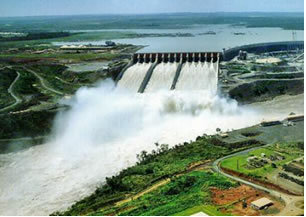Hydroelectric energy is the obtainment of electrical energy by taking advantage of the hydraulic potential of a river. For this process to be carried out, it is necessary to build power plants in rivers that have a high volume of water and that present unevenness in their course.
The force of moving water is known as potential energy, this water passes through the plant's pipes with great force and speed, making the turbines move. In this process, potential energy (water energy) is transformed into mechanical energy (turbine movement). Turbines in motion are connected to a generator, which is responsible for transforming mechanical energy into electrical energy.
Normally, hydroelectric plants are built in places far from consumer centers, this fact raises the values of energy transport, which is transmitted by wires to the cities.
The energy efficiency of hydroelectric plants is very high, around 65.2% (in 2014). The initial investment and maintenance costs are high, however, the cost of fuel (water) is nil.

Itaipu, the largest hydroelectric plant in the world
Currently, hydroelectric plants are responsible for approximately 18% of the world's electricity production. These data are only not greater because few countries have the natural conditions for the installation of hydroelectric plants. The nations that have great hydraulic potential are the United States, Canada, Brazil, Russia and China. In Brazil, more than 95% of the electricity produced comes from hydroelectric plants.
Despite being a renewable energy source and not emitting pollutants, hydroelectric energy is not exempt from environmental and social impacts. The flooding of areas for the construction of dams creates relocation problems for riverside populations, indigenous communities and small farmers. The main environmental impacts caused by the impoundment of water for the formation of immense artificial lakes are: destruction of extensive areas of natural vegetation, riparian forests, the collapse of the banks, the siltation of the riverbeds, damage to the local fauna and flora, changes in the hydraulic regime of rivers, possibilities of transmission of diseases such as schistosomiasis and malaria, extinction of some species of fish.
Do not stop now... There's more after the advertising ;)
See more!
Nuclear energy
Production of radioactive material from minerals.
Solar energy
Alternative type of energy boosted by sunlight.
By Wagner de Cerqueira and Francisco
Graduated in Geography
Brazil School Team
Would you like to reference this text in a school or academic work? Look:
FRANCISCO, Wagner de Cerqueira e. "Hydro-electric energy"; Brazil School. Available in: https://brasilescola.uol.com.br/geografia/energia-hidreletrica.htm. Accessed on June 27, 2021.


